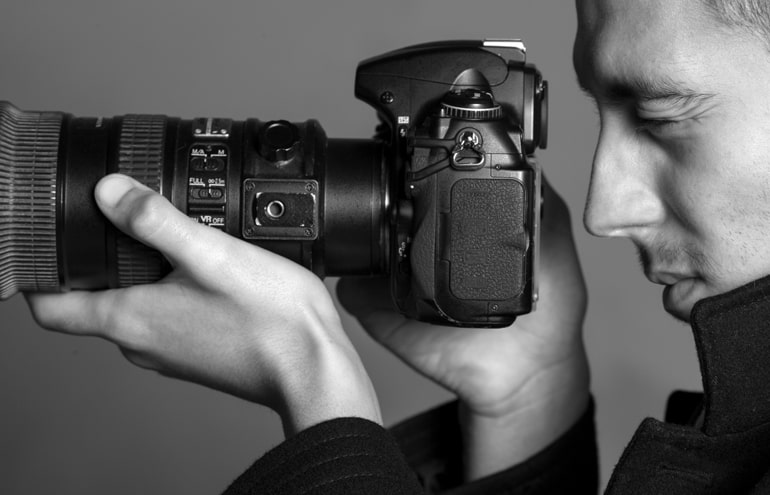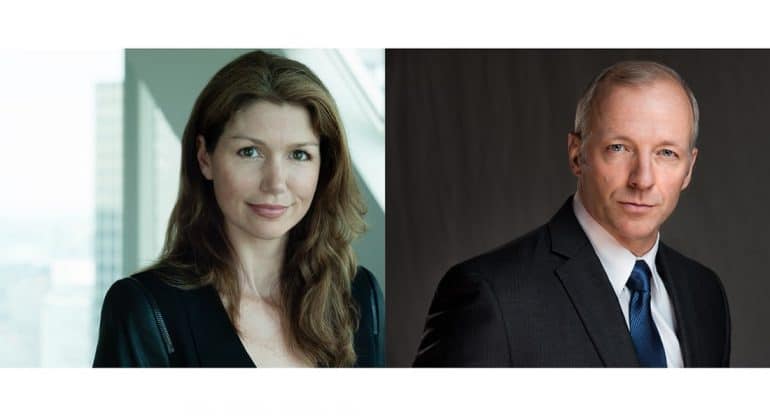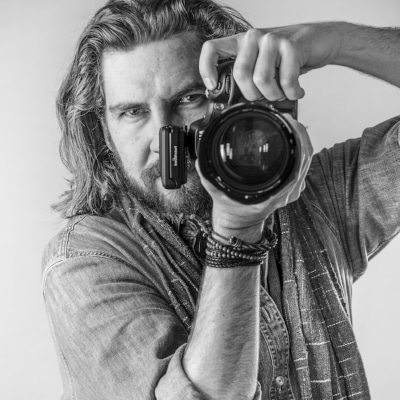It takes more than “point and shoot” to create a professional headshot. Here’s how to take a good headshot and convey professionalism and personality.

Table of contents
- How to Take a Good Headshot: Prepare to Show Your Professionalism
- Confidence in Front of the Camera
- Confide in Your Photographer
- The Physical Game (The Easy Part)
- The Mental Game (The Hard Part)
- How to Do a Headshot: Make Sure Your Personality Shows Up
- Take Advantage of Your Time with Your Photographer
- Always Make This One Technical Request
- How to Take a Good Headshot: Final Two Cents
These days, potential clients are going to look you up online before they ever meet you. They want to see who you are, what you’ve done and where you earned your law degree.
The headshot you’re using on your website and on social media speaks volumes about how you present yourself — and your personal judgment. Legal marketer Kimberly Rice makes this great point:
“Giving people the right visual cues immediately is critical to getting their attention and gaining their trust. To use and/or post a headshot which does not reflect your ‘current look’ is to appear disingenuous or vain; neither a positive take away.”
If you want to rock your next headshot session, it’s worth doing a bit of planning and preparation to capture the image you want. So, here’s how to figure out what your headshot should convey, and some tips on how to get there.
How to Take a Good Headshot: Prepare to Show Your Professionalism
Take yourself seriously and put yourself together. Looking “professional” sounds easy — and we all know what it means. But here are a few things you should pay attention to before you show up for your photo shoot.
1. What will you wear?
Don’t wait until the last minute. Try everything on at home. Look in a mirror and ask, “Does it fit? Do I really love the way it looks on me?” If not, try something else or go shopping.
Here are pointers for choosing an outfit that will help you look great on camera.
- Is there a shirt or top you wear that seems to prompt compliments? Try it on!
- Pick classic cuts and tailored shapes — what’s trendy now might not be next summer.
- Tailored tops are slimming.
- Pick colors that look good on you. Keep things darker than your skin tone. If you think it might wash you out, it probably will.
- Suits in black, gray or navy always look classic and sophisticated.
- Keep patterns to a minimum. They can be distracting, and when you view them online, tight patterns can appear to strobe and take on a moiré pattern on certain screens. This goes for jackets, suits, ties and shirts.
- Iron your stuff. It can make or break a photo.
- Beware of tank tops or camisoles with lace that read too much like lingerie.
- Is your top see-through? Hold it up to a light and check. If so, wear an appropriate layer beneath it.
- Do you have a pet? Use a lint roller on your clothes before you arrive at the shoot. (Sure, show me pictures of your animal friends, but let’s leave their fur at home.)
2. Don’t forget the rest of you.
Hair, makeup, confidence and attitude can make a big difference. Pay attention to the details!
- Skin. If you shave on the day of the shoot, use a fresh razor and hot water and go slow. Avoid razor burn. And if you wake up with a huge pimple, don’t mess with it! It’s much easier to Photoshop a blemish than to correct for swollen, red, irritated skin.
- Stray hairs. Get up close with your mirror and check for stray eyebrows or unruly ear and nose hair. If you can see it, the camera can, too. If you need a facial or a wax go for it, but do it at least a week before the shoot so any irritation from the procedure has time to fade.
- Feeling puffy? Try to drink mostly water 48 hours in advance of your shoot. As the day approaches, take it easy on the caffeine, alcohol and salty snacks.
- Makeup. Whether you do it yourself or hire a professional, men and women alike will benefit from a little bit of makeup and powder in a photograph. You want your makeup to look like you’re not wearing any — fresh, light, natural, even, clean and crisp. We can afford a little drama on the eyes but don’t go too far.
- Teeth. Maybe spend a little time with a white strip. Brush and floss if you ate prior to the shoot, and check for lipstick.
- Hairstyle. Don’t get a haircut the day before. You want to give it time to settle in.
Confidence in Front of the Camera
A great shot requires a bit more than just standing in front of the lens while the photographer clicks away. Portraying confidence is both a physical and mental game.
Confide in Your Photographer
Think of your photographer as your coach, and trust the person to direct you throughout the process to find the best angles and lighting for your face and body. Confiding in a photographer is tough for many lawyers — but what’s said in the headshot room stays in the headshot room. It’s worth sharing your physical insecurities and letting your photographer know what makes you self-conscious or what you want to hide. “I have a lazy eye, I hate my double chin, I don’t like my teeth, my nose always looks crooked in photos, I used to be 30, my eyes get scrunchy when I smile …”
Whatever it is, tell your photographer.
Remember, your photographer wants your shot to look just as amazing as you do. I appreciate it when my clients can be candid with me so I can tweak the lighting and work with them on body positioning and head angles to bring their best features forward. Let me worry about the stuff that makes you anxious so you don’t have to. Plus, it will save time! That’s how to take a good headshot.
The Physical Game (The Easy Part)
Your goal is to have an authentic connection with the camera, and it all starts with your eyes.
- Look right through the lens.
- Keep breathing! The camera picks up everything from tension to breath. (Seriously, I can tell when a person’s not breathing in a photo.)
- Like most physical activities, keep your knees soft and your shoulders square. Get grounded. Take a deep breath and then …
- Listen to your photographer’s directions and follow them as best you can. If they ask you to do something that feels silly, go for it. Chances are, it looks good through the lens.
- It’s best to move slowly. I always say “slo-mo/half inches” when I’m asking people to move their heads. I’m often aiming for a subtle tweak of the light or head tilt, and when people go too far or too fast we can miss it.
- Chin way up? It says “I’m too good for this job.” Chin way down? Says “Please, sir, can I have a job?” We try to avoid these. Chin slightly down, however, can make your eyes seem bigger and more engaged.
- A slight turn or twist of the body is slimming and provides a sense of movement. But a body turned too far away says “I’m hiding something” or “I’m already out the door.”
- A slight tilt of the head can say “I’m listening” or “I understand.”
- Try the chicken. If you push your face slightly toward the camera when you’re facing it straight on, you can define that jawline just a little bit more. Feels weird, but looks great.
- Smile! Smiles are hard for some people. Smiles look best on their way down. Don’t be afraid to go too far or too big and then let it fade or even laugh it up a bit when you’re going for the warm, friendly shot — just keep your eyes on the camera. You’re bound to get something good.
- If you have a habit of putting your tongue between your teeth when you smile, don’t. It looks weird.
- No gum or mints.
- Don’t wanna show your teeth? You might take a tip from Tyra Banks and “smize” with your eyes.
You can (and should) practice this stuff in a mirror.
The Mental Game (The Hard Part)
Forgive me if I start to sound a bit like a self-help book here, but this stuff really helps.
- Try to keep a sense of humor about the whole experience. Relax. Nobody’s gonna get hurt.
- Come to your shoot ready to play and trust that your photographer is going to look after you. Leave your ego at the door and allow yourself to be vulnerable.
- Anxious? Get out of your head and stay positive.
- Have a nonverbal conversation with the camera. Keep it warm, curious, upbeat, friendly, flirty and engaging and let your face follow your thoughts. (There’s no crying in headshots.)
- Be patient with yourself and with your photographer. A great shot doesn’t always happen with the first click. And not every shot has to count. It’s all digital nowadays and you only need one great one.
- If you feel stuck or like you’re just staring at the camera, take a second to regroup and then get back in the game!
That said, I’ve seen how stressed and busy a lawyer can get. Most photographers are really accommodating. If you’re truly having a crappy day (and it isn’t “headshot anxiety” related), and honestly feel like you won’t be able to put your best self out there, see if you can adjust your time slot or trade with someone. It won’t get you out of it, but there’s no sense in wasting time if you’re not ready to go.
How to Do a Headshot: Make Sure Your Personality Shows Up
A great headshot tells a story. Tell your photographer about your practice and how you want to be perceived. Think about breaking the lawyer stereotypes — or play to them. A family lawyer probably doesn’t want the look and intensity of a pit bull litigator … or maybe she does.
Unless your firm has strict requirements for how you dress for headshots, bring a bit of your own personality and style to the shoot. Some of my clients like to wear ties from their alma mater whenever they update their photos, and others are always in a bow tie, or no tie, or a unique pair of glasses. I love that.
Using your own space is another way to show your personality. Work with your photographer to find cool places or backgrounds around your office — but please, no more bookcases in the background!

Take Advantage of Your Time with Your Photographer
I always ask for at least 15 minutes with each of a firm’s attorneys. Plan to use the entire time you have allotted. Try to get as many looks and shots as you can muster. The photographer will likely ask you to vary your expressions and positioning. But why not squeeze in a quick costume change, too? Take some with and without your glasses. With and without your tie. With and without your jacket. Whatever. Options are awesome. You only need one or two great shots in the end, but you might feel like a change down the road. Or maybe you want to use one expression on your firm’s site and something different on LinkedIn or AVVO.
Always Make This One Technical Request
Most photographers are trained to crop as they shoot. I certainly was. Without stepping on your photographer’s toes — let them do their thing — ask that they do several shots in landscape orientation and leave you a bit of headroom. Why? Websites are responsive and the crops of photos will adjust according to various screen sizes. It’ll also give your marketing team more to work with for various mediums. Plus, with a landscape photo, you can always crop it vertically later. It doesn’t work the other way around, I’m sad to say.
How to Take a Good Headshot: Final Two Cents
With your headshot, you’ve got a split-second chance to show the world how polished, skilled and approachable you are. It’s worth your attention. Do your homework. Take a deep breath. Arrive with a sense of play and collaboration.
Illustration ©iStockPhoto.com; headshot examples, ClintonBPhotography






















